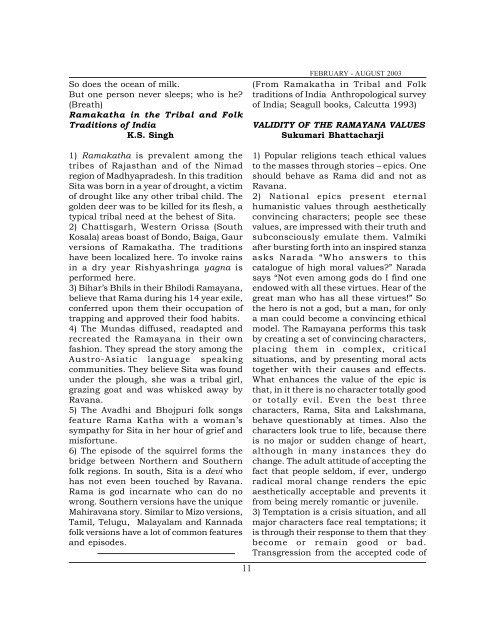Epics in Imprints-1.pdf - Vivekananda Kendra Prakashan
Epics in Imprints-1.pdf - Vivekananda Kendra Prakashan
Epics in Imprints-1.pdf - Vivekananda Kendra Prakashan
Create successful ePaper yourself
Turn your PDF publications into a flip-book with our unique Google optimized e-Paper software.
So does the ocean of milk.<br />
But one person never sleeps; who is he?<br />
(Breath)<br />
Ramakatha <strong>in</strong> the Tribal and Folk<br />
Traditions of India<br />
K.S. S<strong>in</strong>gh<br />
1) Ramakatha is prevalent among the<br />
tribes of Rajasthan and of the Nimad<br />
region of Madhyapradesh. In this tradition<br />
Sita was born <strong>in</strong> a year of drought, a victim<br />
of drought like any other tribal child. The<br />
golden deer was to be killed for its flesh, a<br />
typical tribal need at the behest of Sita.<br />
2) Chattisgarh, Western Orissa (South<br />
Kosala) areas boast of Bondo, Baiga, Gaur<br />
versions of Ramakatha. The traditions<br />
have been localized here. To <strong>in</strong>voke ra<strong>in</strong>s<br />
<strong>in</strong> a dry year Rishyashr<strong>in</strong>ga yagna is<br />
performed here.<br />
3) Bihar’s Bhils <strong>in</strong> their Bhilodi Ramayana,<br />
believe that Rama dur<strong>in</strong>g his 14 year exile,<br />
conferred upon them their occupation of<br />
trapp<strong>in</strong>g and approved their food habits.<br />
4) The Mundas diffused, readapted and<br />
recreated the Ramayana <strong>in</strong> their own<br />
fashion. They spread the story among the<br />
Austro-Asiatic language speak<strong>in</strong>g<br />
communities. They believe Sita was found<br />
under the plough, she was a tribal girl,<br />
graz<strong>in</strong>g goat and was whisked away by<br />
Ravana.<br />
5) The Avadhi and Bhojpuri folk songs<br />
feature Rama Katha with a woman’s<br />
sympathy for Sita <strong>in</strong> her hour of grief and<br />
misfortune.<br />
6) The episode of the squirrel forms the<br />
bridge between Northern and Southern<br />
folk regions. In south, Sita is a devi who<br />
has not even been touched by Ravana.<br />
Rama is god <strong>in</strong>carnate who can do no<br />
wrong. Southern versions have the unique<br />
Mahiravana story. Similar to Mizo versions,<br />
Tamil, Telugu, Malayalam and Kannada<br />
folk versions have a lot of common features<br />
and episodes.<br />
11<br />
FEBRUARY - AUGUST 2003<br />
(From Ramakatha <strong>in</strong> Tribal and Folk<br />
traditions of India Anthropological survey<br />
of India; Seagull books, Calcutta 1993)<br />
VALIDITY OF THE RAMAYANA VALUES<br />
Sukumari Bhattacharji<br />
1) Popular religions teach ethical values<br />
to the masses through stories – epics. One<br />
should behave as Rama did and not as<br />
Ravana.<br />
2) National epics present eternal<br />
humanistic values through aesthetically<br />
conv<strong>in</strong>c<strong>in</strong>g characters; people see these<br />
values, are impressed with their truth and<br />
subconsciously emulate them. Valmiki<br />
after burst<strong>in</strong>g forth <strong>in</strong>to an <strong>in</strong>spired stanza<br />
asks Narada “Who answers to this<br />
catalogue of high moral values?” Narada<br />
says “Not even among gods do I f<strong>in</strong>d one<br />
endowed with all these virtues. Hear of the<br />
great man who has all these virtues!” So<br />
the hero is not a god, but a man, for only<br />
a man could become a conv<strong>in</strong>c<strong>in</strong>g ethical<br />
model. The Ramayana performs this task<br />
by creat<strong>in</strong>g a set of conv<strong>in</strong>c<strong>in</strong>g characters,<br />
plac<strong>in</strong>g them <strong>in</strong> complex, critical<br />
situations, and by present<strong>in</strong>g moral acts<br />
together with their causes and effects.<br />
What enhances the value of the epic is<br />
that, <strong>in</strong> it there is no character totally good<br />
or totally evil. Even the best three<br />
characters, Rama, Sita and Lakshmana,<br />
behave questionably at times. Also the<br />
characters look true to life, because there<br />
is no major or sudden change of heart,<br />
although <strong>in</strong> many <strong>in</strong>stances they do<br />
change. The adult attitude of accept<strong>in</strong>g the<br />
fact that people seldom, if ever, undergo<br />
radical moral change renders the epic<br />
aesthetically acceptable and prevents it<br />
from be<strong>in</strong>g merely romantic or juvenile.<br />
3) Temptation is a crisis situation, and all<br />
major characters face real temptations; it<br />
is through their response to them that they<br />
become or rema<strong>in</strong> good or bad.<br />
Transgression from the accepted code of

















